#trans pecos ratsnakes
Note
Concerning that last ask asking about if there were any snakes in nature that had colors like the nonbinary or trans flag, that Trans Pecos Rat Snake you used as an example has absolutely no thoughts in its head. It just looks like all that there is going on up there is the mii channel theme. XD
I'm delighted to let you know that Trans Pecos rats just Look Like That. All the time. Always. Every single one.

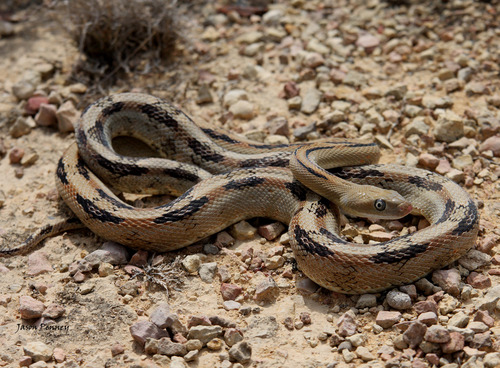
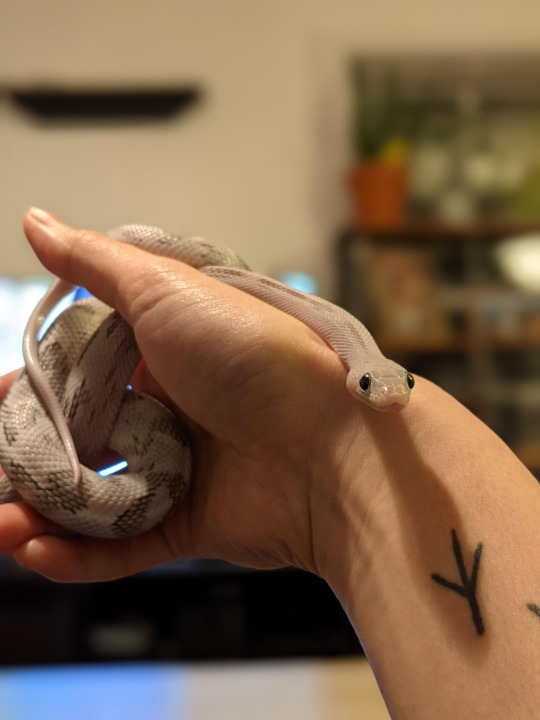
When my own Trans Pecos ratsnake, Stede, was a baby he was a bit pissy (he grew out of that fast) and it was absolutely hilarious because he was like "hey! Don't you trifle me! I'll bite you, I mean it!"
But he looked exactly like this

Absolutely zero difference between these pictures

Trans Pecos rats are great, they're sweethearts and such curious, goofy little snakes. Stede makes me laugh every single day.
243 notes
·
View notes
Text
tbh still not doing great bc my life is just overall not the greatest however . i have band rehearsal tmrw and then pkmn on friday and we're getting some new snakes at work tomorrow who i will be meeting next week (i dont work again till tuesday) and that has me very excited. my supervisor isnt sure what all is being rehomed from the other division to us but she DOES know we're getting at least 1 trans pecos which is exciting bc i fucking LOVE ratsnakes and trans pecos r so cute....
#kage rattles#stepmoms not doing anything particularly heinous today shes just getting on my nerves#shes been sick as hell so i havent been seeing much of her plus ive not rly been home#not to be a dick but i really hope that if we get any gecks there arent any leos....leos are fine i just dont love them tbh#but then again we dont really keep leos very long from what im told either so idk#its annoying that they dont fucking tell anyone except for the managers whats all coming in like why are you being so secretive#we kinda need to know that because if we get something that eats a feed we dont have we need to get that??#the managers are told that they arent allowed to disclose ''company secrets'' but i think [REDACTED] is just being insane bc#but i can literally go to a tour if they have one and see what they have so idk whats so secret can you just fucking tell us whats coming#no shade to the managers bc theyre just doing what THEIR boss tells them and theyre just as confused as us but like ????????
0 notes
Text


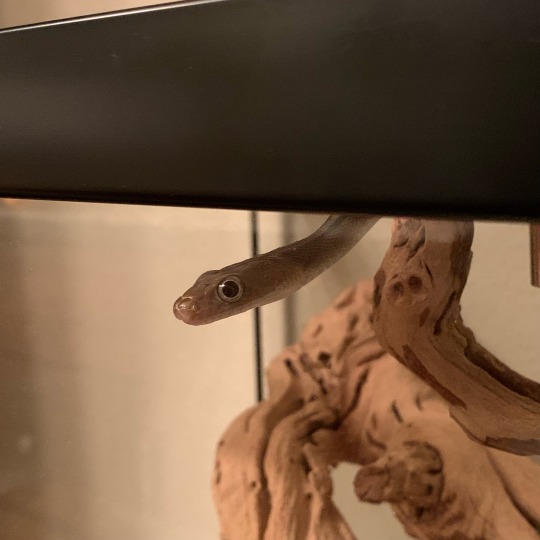


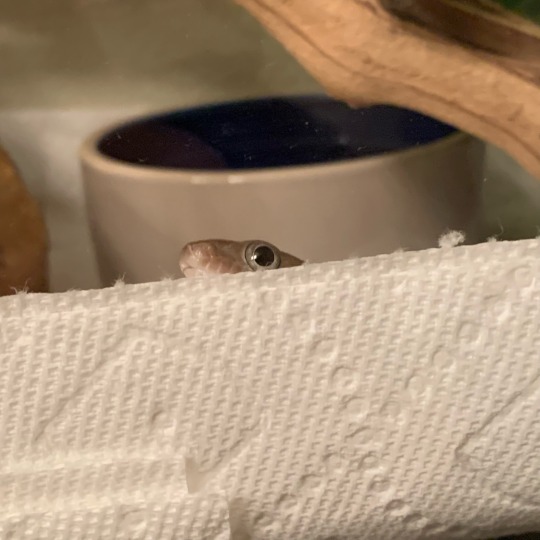

This is Echo. He is a cartoon.
12 notes
·
View notes
Photo
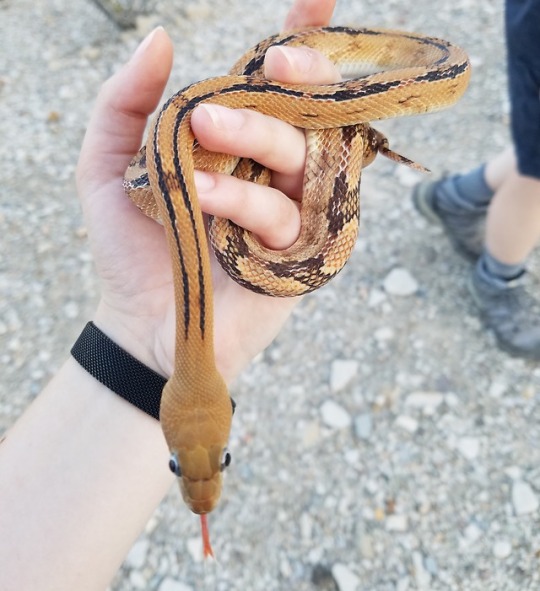
I spent the previous week in Big Bend National Park helping my professor study bat colonies and distribution within the park. While we were netting over by Mariscal Mine, I found this cute little Trans Pecos Ratsnake! (Bogertophis subocularis)
1 note
·
View note
Note
I am looking at purchasing my first snake and have been researching for the better part of the year. I have been debating between a cal king, rat snake, or a gopher snake. Was wondering if you have any advice on enclosures or which may be a better first reptile.
Hi there!
These are all excellent choices and they have very similar enclosure needs. As long as you’re getting a captive-bred friend and not a wild-caught specimen I think any of these would be very suitable for a first reptile pet!
I would caution you that there are many different types of rat snake and not all are great beginner species, especially if we’re not counting corn snakes in this group. While the North American species are very easy to keep (as long as you have a large enough enclosure!) they do tend to be defensive and flighty, even if regularly handled. A really good choice here (again, besides the obvious corn snake) might be a Russian rat snake, which are somewhat smaller than Texas or black ratsnakes and still very pretty. Other great choices are captive bred Great Plains ratsnakes, Baird’s ratsnakes, or the gorgeous and slightly more husbandry-specific Trans-Pecos ratsnake.
I would also caution you that all of these choices are STINKY when they have a reason to be. King, rat, and gopher snakes all employ a funky musk as their first means of defense and they can occasionally musk even when they’re not feeling particularly threatened. Like when you’ve already been holding them for a while and they suddenly decide that you need some incredibly toxic-smelling perfume all over your fresh clean jeans…If you’re down with the stinkness, though, and you’re prepared to have a six-foot long enclosure (minimum!) for your snake when they’re an adult, I think the best choice is the one you like the most.
I wish you happy choosing!
#answers to questions#text post#snake#snakes#reptile#reptiles#reptiblr#rat snake#gopher snake#kingsnake#snake husbandry#snake keeping#beginner snakes
46 notes
·
View notes
Photo

2019 Trans-Pecos Ratsnake het albino PH blonde Male. Thomas is eating frozen thawed rodents and has an placid disposition. As always these are photos of the actual snake available. Email us at [email protected] or call 281-608-7745. Payment plans, Credit/Debt Cards, Venmo, PayPal, and shipping are available. Kingwood, Texas $200.00 www.GopherYourPet.com (at Kingwood, Texas) https://www.instagram.com/p/B9F-I3uBBEd/?igshid=1mt7309x0yeen
0 notes
Note
Which snakes could you recommend to someone with an intermediate herp background but is a novice to snakes? I have a gargoyle gecko and I take care of my fiancé's leachie gecko, but I've never had a snake. I would go with ball python but my partner doesn't like fat snakes lol. Thank you! I love your blog so much btw
Hey anon,
Sorry for the delay in my response.
Glad you enjoy the blog! I say this a lot but it really depends what you want from a snake. Do you want somthing that will tolerate handling or would be happy with an active display animal, do you want an animal that will be visible in the day or not fussed if the snake is a burrowing nocturnal dirt snake? What size restrictions are you working with for adult caging?
With all that in mind i’ll direct you to this post
https://rainbowsnakes.tumblr.com/post/163090996169/what-would-you-tell-a-complete-beginner-i-want-to#notes
As for species reccommendations...
I love rat snakes. Beauty snakes, russian rat snakes and japenese rat snakes Trans Pecos Ratsnakes, bairds rat snakes, yellow rat snakes, black rat snakes can all be pretty interesting. Followers please feel free to add species recomendations to this!
28 notes
·
View notes
Text
Herp Taxa
CNAH: North American Herpetofauna: Reptilia: Squamata (part)
Names that differ in any way from those published in the most most recent joint Society names list (see introduction)
About CNAH have their Standard English name shown in green.
Statement
of Purpose Reptilia Laurenti, 1768 - Reptiles
Squamata (part) Oppel, 1811 - Snakes
CNAH Board
Boidae Gray, 1842 - Boas
CNAH Officers Charina Gray, 1849 - Rubber Boas
C. bottae (Blainville, 1835) - Northern Rubber Boa
CNAH Awards
C. umbratica Klauber, 1943 - Southern Rubber Boa
CNAH Donors Lichanura Cope, 1861 - Rosy Boas
L. orcutti (Stejneger 1889) - Northern Three-lined Boa
JNAH
L. trivirgata (Cope, 1861) - Rosy Boa
Contemporary
Herpetology
Colubridae Oppel, 1811 - Harmless Egg-Laying Snakes
Contact Us
Arizona Kennicott, 1859 - Glossy Snakes
A. elegans Kennicott, in Baird, 1859 - Glossy Snake
A. e. arenicola Dixon, 1960 - Texas Glossy Snake
A. e. candida Klauber, 1946 - Mohave Glossy Snake
A. e. eburnata Klauber, 1946 - Desert Glossy Snake
A. e. elegans Kennicott, in Baird, 1859 - Kansas Glossy Snake
A. e. noctivaga Klauber, 1946 - Arizona Glossy Snake
A. e. occidentalis Blanchard, 1924 - California Glossy Snake
A. e. philipi Klauber, 1946 - Painted Desert Glossy Snake
Bogertophis Dowling & Price, 1988 - Desert Ratsnakes
B. rosaliae (Mocquard, 1899) - Baja California Ratsnake
B. subocularis (Brown, 1901) - Trans-Pecos Ratsnake
B. s. subocularis (Brown, 1901) - Northern Trans-Pecos Ratsnake
Cemophora Cope, 1860 - Scarletsnakes
C. coccinea (Blumenbach, 1788) - Scarletsnake
C. lineri Williams, Brown & Wilson, 1966 - Texas Scarletsnake
Coluber Linnaeus, 1758 - North American Racers, Coachwhips, and Whipsnakes
C. constrictor Linnaeus, 1758 - North American Racer
C. c. anthicus (Cope, 1862) - Buttermilk Racer
C. c. constrictor Linnaeus, 1758 - Northern Black Racer
C. c. etheridgei Wilson, 1970 - Tan Racer
C. c. flaviventris Say in James, 1822 - Eastern Yellow-bellied Racer
C. c. foxii (Baird and Girard, 1853) - Blue Racer
C. c. helvigularis Auffenberg, 1955 - Brown-chinned Racer
C. c. latrunculus Wilson, 1970 - Black-masked Racer
C. c. mormon Baird & Girard, 1852 - Western Yellow-bellied Racer
C. c. oaxaca (Jan, 1863) - Mexican Racer
C. c. paludicola Auffenberg & Babbitt, 1953 - Everglades Racer
C. c. priapus Dunn & Wood, 1939 - Southern Black Racer
Drymarchon Fitzinger, 1843 - Indigo Snakes
D. couperi (Holbrook, 1842) - Eastern Indigo Snake
D. melanurus (Duméril, Bibron & Duméril, 1853) - Central American Indigo Snake
D. m. erebennus (Cope, 1860) - Texas Indigo Snake
Drymobius Fitzinger, 1843 - Neotropical Racers
D. margaritiferus (Schlegel, 1837) - Speckled Racer
D. m. margaritiferus (Schlegel, 1837) - Northern Speckled Racer
Ficimia Gray, 1849 - Eastern Hook-nosed Snakes
F. streckeri Taylor, 1931 - Tamaulipan Hook-nosed Snake
Gyalopion Cope, 1860 - Western Hook-nosed Snakes
G. canum Cope, 1861 “1860” - Chihuahuan Hook-nosed Snake
G. quadrangulare (Günther, 1893 in Salvin and Godman, 1885-1902) - Thornscrub Hook-nosed Snake
Lampropeltis Fitzinger, 1843 - Kingsnakes
L. alterna (Brown, 1901) - Gray-banded Kingsnake
L. annulata Kennicott, 1860 - Mexican Milksnake
L. californiae (Blainville, 1835) - California Kingsnake
L. calligaster (Harlan, 1827) - Prairie Kingsnake
L. elapsoides (Holbrook, 1838) - Scarlet Kingsnake
L. extenuata (Brown, 1890) - Short-tailed Kingsnake
L. gentilis (Baird & Girard, 1853) - Western Milksnake
L. getula (Linnaeus, 1766) - Eastern Kingsnake
L. holbrooki Stejneger, 1902 - Speckled Kingsnake
L. knoblochi (Taylor, 1940) - Knobloch’s Mountain Kingsnake
L. nigra (Yarrow, 1882) - Eastern Black Kingsnake
L. occipitolineata Price, 1987 - South Florida Mole Kingsnake
L. pyromelana (Cope, 1866) - Pyro Mountain Kingsnake
L. p. infralabialis Tanner, 1953 - Utah Mountain Kingsnake
L. p. pyromelana (Cope, 1867) - Arizona Mountain Kingsnake
L. rhombomaculata (Holbrook, 1840) - Mole Kingsnake
L. splendida (Baird & Girard, 1853) - Desert Kingsnake
L. triangulum (Lacépède, 1789) - Eastern Milksnake
L. zonata (Blainville, 1835) - California Mountain Kingsnake
Masticophis Baird & Girard, 1853 - Whipsnakes
M. bilineatus Jan, 1863 - Sonoran Whipsnake
M. flagellum (Shaw, 1802) - Coachwhip
M. f. cingulum (Lowe & Woodin, 1954) - Sonoran Coachwhip
M. f. flagellum Shaw, 1802 - Eastern Coachwhip
M. f. lineatulus (Smith, 1941) - Lined Coachwhip
M. f. piceus (Cope, 1892) - Red Racer
M. f. ruddocki (Brattstrom & Warren, 1953) - San Joaquin Coachwhip
M. f. testaceus Say in James, 1822 - Western Coachwhip
M. fuliginosus (Cope, 1895) - Baja California Coachwhip
M. lateralis (Hallowell, 1853) - Striped Racer
M. l. euryxanthus (Riemer, 1954) - Alameda Striped Racer
M. l. lateralis (Hallowell, 1853) - California Striped Racer
M. schotti (Baird & Girard, 1853) - Schott''s Whipsnake
M. s. ruthveni (Ortenburger, 1923) - Ruthven''s Whipsnake
M. s. schotti (Baird & Girard, 1853) - Schott’s Striped Whipsnake
M. taeniatus (Hallowell, 1852) - Striped Whipsnake
M. t. girardi (Stejneger & Barbour, 1917) - Central Texas Whipsnake
M. t. taeniatus (Hallowell, 1852) - Desert Striped Whipsnake
Opheodrys Fitzinger, 1843 - Greensnakes
O. aestivus (Linnaeus, 1766) - Rough Greensnake
O. a. aestivus (Linnaeus, 1766) - Northern Rough Greensnake
O. a. carinatus Grobman, 1984 - Florida Rough Greensnake
O. vernalis (Harlan, 1827) - Smooth Greensnake
Oxybelis Wagler, 1830 - American Vinesnakes
O. aeneus (Wagler, 1824) - Brown Vinesnake
Pantherophis Fitzinger, 1843 - North American Ratsnakes
P. alleghaniensis (Holbrook, 1836) - Eastern Ratsnake
P. bairdi (Yarrow, 1880) - Baird's Ratsnake
P. emoryi (Baird & Girard, 1853) - Great Plains Ratsnake
P. guttatus (Linnaeus, 1766) - Red Cornsnake
P. obsoletus (Say in James, 1822) - Western Ratsnake
P. ramspotti (Crother, White, Savage, Eckstut, Graham & Gardner, 2011) - Western Foxsnake
P. slowinskii (Burbrink, 2002) - Slowinski's Cornsnake
P. spiloides (Duméril, Bibron & Duméril, 1854) - Gray Ratsnake
P. vulpinus (Baird & Girard, 1853) - Eastern Foxsnake
Phyllorhynchus Stejneger, 1890 - Leaf-nosed Snakes
P. browni Stejneger, 1890 - Saddled Leaf-nosed Snake
P. decurtatus (Cope, 1868) - Spotted Leaf-nosed Snake
Pituophis Holbrook, 1842 - Bullsnakes, Pinesnakes, and Gophersnakes
P. catenifer (Blainville, 1835) - Gophersnake
P. c. affinis Hallowell, 1852 - Sonoran Gophersnake
P. c. annectens Baird & Girard, 1853 - San Diego Gophersnake
P. c. catenifer (Blainville, 1835) - Pacific Gophersnake
P. c. deserticola Stejneger, 1893 - Great Basin Gophersnake
P. c. pumilus Klauber, 1946 - Santa Cruz Gophersnake
P. c. sayi (Schlegel, 1837) - Bullsnake
P. melanoleucus (Daudin, 1803) - Eastern Pinesnake
P. m. lodingi Blanchard, 1924 - Black Pinesnake
P. m. melanoleucus (Daudin, 1803) - Northern Pinesnake
P. m. mugitus Barbour, 1921 - Florida Pinesnake
P. ruthveni Stull, 1929 - Louisiana Pinesnake
Rhinocheilus Baird & Girard, 1853 - Long-nosed Snakes
R. lecontei Baird & Girard, 1853 - Long-nosed Snake
Salvadora Baird & Girard, 1853 - Patch-nosed Snakes
S. grahamiae Baird & Girard, 1853 - Eastern Patch-nosed Snake
S. g. grahamiae Baird & Girard, 1853 - Mountain Patch-nosed Snake
S. g. lineata Schmidt, 1940 - Texas Patch-nosed Snake
S. hexalepis (Cope, 1866) - Western Patch-nosed Snake
S. h. deserticola Schmidt, 1940 - Big Bend Patch-nosed Snake
S. h. hexalepis (Cope, 1866) - Desert Patch-nosed Snake
S. h. mojavensis Bogert, 1945 - Mohave Patch-nosed Snake
S. h. virgultea Bogert, 1935 - Coast Patch-nosed Snake
Senticolis Dowling & Fries, 1987 - Green Ratsnakes
S. triaspis (Cope, 1866) - Green Ratsnake
S. t. intermedia (Boettger, 1883) - Northern Green Ratsnake
Sonora Baird & Girard, 1853 - North American Groundsnakes
S. annulata (Baird, 1859 “1858”) - Colorado Desert Shovel-nosed Snake
S. episcopa (Kennicott 1859) - Great Plains Groundsnake
S. occipitalis (Hallowell, 1854) - Western Shovel-nosed Snake
S. o. klauberi (Stickel, 1941) - Tucson Shovel-nosed Snake
S. o. occipitalis (Hallowell, 1854) - Mohave Shovel-nosed Snake
S. o. talpina Klauber, 1951 - Nevada Shovel-nosed Snake
S. palarostris (Klauber, 1937) - Sonoran Shovel-nosed Snake
S. p. organica Klauber, 1951 - Organ Pipe Shovel-nosed Snake
S. semiannulata Baird & Girard, 1853 - Western Groundsnake
S. straminea (Cope, 1860) - Variable Sandsnake
S. taylori (Boulenger, 1894) - Southern Texas Groundsnake
Tantilla Baird & Girard, 1853 - Black-headed, Crowned, and Flat-headed Snakes
T. atriceps (Günther, 1895 in Salvin and Godman, 1885-1902) - Mexican Black-headed Snake
T. coronata Baird & Girard, 1853 - Southeastern Crowned Snake
T. cucullata Minton, 1956 - Trans-Pecos Black-headed Snake
T. gracilis Baird & Girard, 1853 - Flat-headed Snake
T. hobartsmithi Taylor, 1937 - Smith’s Black-headed Snake
T. nigriceps Kennicott, 1860 - Plains Black-headed Snake
T. oolitica Telford, 1966 - Rim Rock Crowned Snake
T. planiceps (Blainville, 1835) - Western Black-headed Snake
T. relicta Telford, 1966 - Florida Crowned Snake
T. r. neilli Telford, 1966 - Central Florida Crowned Snake
T. r. pamlica Telford, 1966 - Coastal Dunes Crowned Snake
T. r. relicta Telford, 1966 - Peninsula Crowned Snake
T. wilcoxi Stejneger, 1902 - Chihuahuan Black-headed Snake
T. yaquia Smith, 1942 - Yaqui Black-headed Snake
Trimorphodon Cope, 1861 - Lyresnakes
T. lambda Cope, 1886 - Sonoran Lyresnake
T. lyrophanes (Cope, 1860) - California Lyresnake
T. vilkinsonii Cope, 1886 - Texas Lyresnake
Crotalidae Oppel, 1811 - Pitvipers
Agkistrodon Palisot de Beauvois, 1799 - American Moccasins
A. conanti Gloyd, 1969 - Florida Cottonmouth
A. contortrix (Linnaeus, 1766) - Eastern Copperhead
A. laticinctus (Gloyd & Conant, 1934) - Broad-banded Copperhead
A. piscivorus (Lacépède, 1789) - Northern Cottonmouth
Crotalus Linnaeus, 1758 - Rattlesnakes
C. adamanteus Palisot de Beauvois, 1799 - Eastern Diamond-backed Rattlesnake
C. atrox Baird & Girard, 1853 - Western Diamond-backed Rattlesnake
C. cerastes Hallowell, 1854 - Sidewinder
C. c. cerastes Hallowell, 1854 - Mohave Desert Sidewinder
C. c. cercobombus Savage & Cliff, 1953 - Sonoran Sidewinder
C. c. laterorepens Klauber, 1944 - Colorado Desert Sidewinder
C. cerberus (Coues, 1875) - Arizona Black Rattlesnake
C. horridus Linnaeus, 1758 - Timber Rattlesnake
C. lepidus (Kennicott, 1861) - Rock Rattlesnake
C. l. klauberi Gloyd, 1936 - Banded Rock Rattlesnake
C. l. lepidus (Kennicott, 1861) - Mottled Rock Rattlesnake
C. molossus Baird & Girard, 1853 - Black-tailed Rattlesnake
C. m. molossus Baird & Girard, 1853 - Northern Black-tailed Rattlesnake
C. oreganus Holbrook, 1840 - Western Rattlesnake
C. o. abyssus Klauber, 1930 - Grand Canyon Rattlesnake
C. o. concolor Woodbury, 1929 - Midget Faded Rattlesnake
C. o. helleri Meek, 1905 - Southern Pacific Rattlesnake
C. o. lutosus Klauber, 1930 - Great Basin Rattlesnake
C. o. oreganus Holbrook, 1840 - Northern Pacific Rattlesnake
C. ornatus Hallowell 1954 - Eastern Black-tailed Rattlesnake
C. pricei Van Denburgh, 1895 - Twin-spotted Rattlesnake
C. p. pricei Van Denburgh, 1895 - Western Twin-spotted Rattlesnake
C. pyrrhus (Cope, 1867 “1866”) - Southwestern Speckled Rattlesnake
C. ruber Cope, 1892 - Red Diamond Rattlesnake
C. scutulatus (Kennicott, 1861) - Mohave Rattlesnake
C. s. scutulatus (Kennicott, 1861) - Northern Mohave Rattlesnake
C. stephensi Klauber, 1930 - Panamint Rattlesnake
C. tigris Kennicott, 1859 - Tiger Rattlesnake
C. viridis (Rafinesque, 1818) - Prairie Rattlesnake
C. willardi Meek, 1905 - Ridge-nosed Rattlesnake
C. w. obscurus Harris, 1974 - New Mexico Ridge-nosed Rattlesnake
C. w. willardi Meek, 1905 - Arizona Ridge-nosed Rattlesnake
Sistrurus Garman, 1883 - Massasauga and Pygmy Rattlesnakes
S. catenatus (Rafinesque, 1818) - Eastern Massasauga
S. miliarius (Linnaeus, 1766) - Pygmy Rattlesnake
S. m. barbouri Gloyd, 1935 - Dusky Pygmy Rattlesnake
S. m. miliarius (Linnaeus, 1766) - Carolina Pygmy Rattlesnake
S. m. streckeri Gloyd, 1935 - Western Pygmy Rattlesnake
S. tergeminus (Say in James, 1822) - Western Massasauga
S. t. edwardsii (Baird & Girard, 1853) - Desert Massasauga
S. t. tergeminus (Say in James, 1822) - Prairie Massasauga
Dipsadidae Bonaparte, 1838 - Rear-Fanged Snakes
Carphophis Gervais, 1843 - North American Wormsnakes
C. amoenus (Say, 1825) - Common Wormsnake
C. a. amoenus (Say, 1825) - Eastern Wormsnake
C. a. helenae (Kennicott, 1859) - Midwestern Wormsnake
C. vermis (Kennicott, 1859) - Western Wormsnake
Coniophanes Hallowell, 1860 - Black-striped Snakes
C. imperialis (Baird, 1859) - Regal Black-striped Snake
C. i. imperialis (Baird, 1859) - Tamaulipan Black-striped Snake
Contia Baird & Girard, 1853 - Sharp-tailed Snakes
C. longicauda Feldman & Hoyer, 2010 - Forest Sharp-tailed Snake
C. tenuis (Baird & Girard, 1852) - Common Sharp-tailed Snake
Diadophis Baird & Girard, 1853 - Ring-necked Snakes
D. punctatus (Linnaeus, 1766) - Ring-necked Snake
D. p. acricus Paulson, 1968 - Key Ring-necked Snake
D. p. amabilis Baird & Girard, 1853 - Pacific Ring-necked Snake
D. p. arnyi Kennicott, 1859 - Prairie Ring-necked Snake
D. p. edwardsii (Merrem, 1820) - Northern Ring-necked Snake
D. p. modestus Bocourt, 1866 - San Bernardino Ring-necked Snake
0 notes
Photo
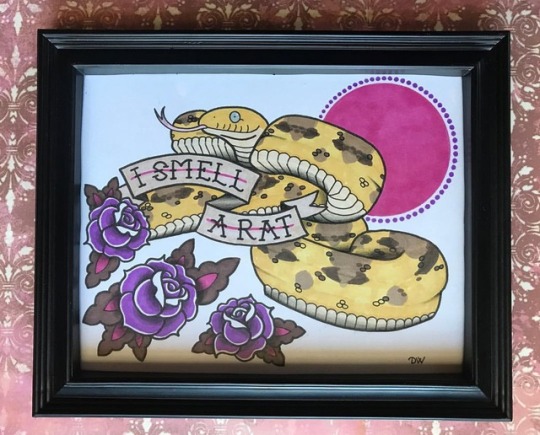
8x10 Trans-Pecos Ratsnake Unframed, $35 shipped. #ratsnake #bogertophis #subocularis
0 notes
Note
Stede the Trans Pecos ratsnake? Congrats on your snake’s gender
Trans-Pecos is a region in Texas where Trans-Pecos ratsnakes live! I get this comment like fifty times every time I bring Stede up but I promise, hand on my heart, that's just what these snakes are called and unfortunately they are not all transgender.

Though it would be cool if Stede was trans, snakes seem to have no concept of gender (every snake's gender is "snake").
203 notes
·
View notes
Text
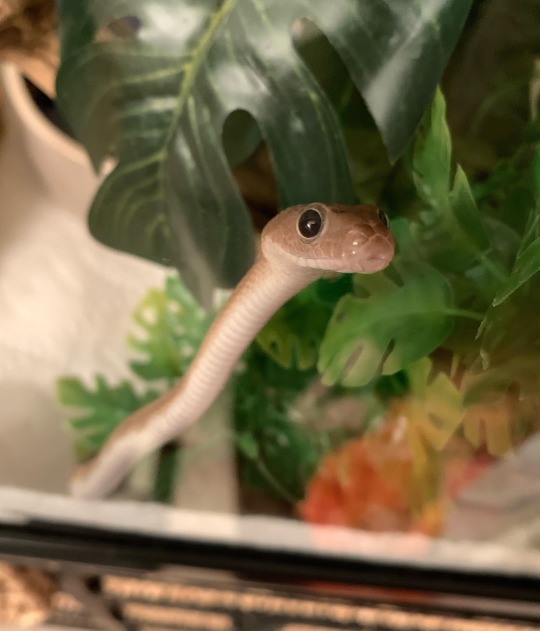
Echo would like to wish you all a good morning.
7 notes
·
View notes
Photo

Young adult trans Pecos ratsnake $150.00 if interested please call exotic pets 702-631-7387 #pet #petsofinstagram #animals #animalsofinstagram #snake #snakesofinstagram #reptilesofinstagram #reptile #lizard #lizardsofinstagram #arachnids #arachnidsofinstagram (at Exotic Pets Las Vegas)
#reptile#petsofinstagram#lizardsofinstagram#snakesofinstagram#arachnids#pet#arachnidsofinstagram#reptilesofinstagram#animalsofinstagram#animals#lizard#snake
0 notes
Note
This isn't a question, but a thank you for introducing me to Trans-Pecos rat snakes. They're the purest example of an OwO face I've ever seen. Like little reptilian anime characters. I love that for them.
Trans Pecos ratsnakes are absolutely adorable. Their colors are beautiful and their naturally large eyes are incredibly goofy and endearing.

My own Trans Pecos ratsnake, Stede, is an amazing snake and he'll make an incredible ambassador one day, but he was a pretty snappy and defensive little baby (typical for lots of ratsnakes). He outgrew it fast, but for a while there he'd just trying to look big and scary and it was so hard to take him seriously because he looked like this

161 notes
·
View notes
Note
Quick question, what substrate do you use for your trans Pecos rat snake? Mine is in aspen for now but I’m looking for something more naturalistic in the near future
Mine is on a playsand/soil mixture, we use 30% playsand to 70% untreated topsoil. I really didn't mind aspen for him but he's the clumsiest ratsnake who ever lived so something softer is just better for him. You might have to experiment with the ratio to keep your humidity levels just right, but that's what works for us.
Plus, even if your snake doesn't like to burrow in the aspen, I've found that the sand/soil mixture really makes my guy want to indulge in a nice dig every now and again! Ratsnakes in general just seem to like digging in soil mixtures more than aspen, and it's a great avenue for more opportunities to engage with their natural instincts!
67 notes
·
View notes
Note
i have an oddly specific question that i hope isn't too silly: i was reading a book about snakes and there was a brief section on morphology and mentioned that, broadly speaking, diurnal snakes have round pupils vs nocturnal snakes having slit pupils; the same book showed the trans-pecos rat snake as an example and said theyre diurnal much of the year but nocturnal in the hottest parts of the summer. Online, all the sources I can find say that they're nocturnal. i know sometimes books can be outdated but then I also read online that the eastern rat snake switches from nocturnal diurnal patterms between seasons. What are your thoughts here- what seems the most likely? In a situation like this what source would make you the most confident?
Like many North American ratsnakes (and indeed a lot of North American colubrids), Trans Pecos rats are best described as "cathemeral," which basically means they do whatever they damn well please. Many cathemeral snakes will follow the behavior pattern you read in your book, which I'd say sounds like a solid source - it's very common for wild cathemeral snakes to be diurnal for most of the year and nocturnal during deep summer.
I think the reason many online sources say they're nocturnal is because many of those sources are written not by academics but by people keeping snakes as pets, and cathemeral snakes are hard for keepers to wrap their heads around. With ideal temperatures throughout the year, pet snakes who are cathemeral might behave like nocturnal snakes or like diurnal snakes, or they might switch it up with the seasons, or they might just do whatever they feel like. I've noticed my own pet Trans Pecos ratsnake tends to behave more like a nocturnal snake throughout the year, and the same is true of many others I've met.
It reminds me of an old cornsnake-keeper joke: is a cornsnake diurnal or nocturnal? Yes.
94 notes
·
View notes
Note
Who is the dumbest snake you’ve ever met? Like I’m-not-even-sure-how-you’re-alive level dumb. Absolutely brainless. The lights are on but nobody has ever been home. I say all of this with love, and with the knowledge that it’s probably a hognose.
So, I love my sweet hognose Sirius with my entire heart. He's one of the best snakes in the world and I love him so so much. But, like, the lights aren't even on up there. He has never had a thought in his entire life.
For the complete first year of his life he insisted on eating every single pinky mouse I gave him sideways. Every week he folded those things into his mouth like a taco and just...forced 'em down like that. He did not learn until he was like a year old and it suddenly clicked that it would be easier to eat them from any other direction. When you hold him, he'll spend a while trying to burrow between your fingers and just be completely clueless why that isn't working out for him. He tries to eat the walls of his enclosure on a very regular basis.
Also, honorable mention to my Trans Pecos ratsnake Stede, who is completely brainless but in a way that makes it seem he's like this by choice. He's not a dumb snake. He's an ambassador in training and he's legit one of the most polite, easiest snakes I've ever had the pleasure of working with. He picks things up quickly and he has a great attitude, I love him to death.
But. He makes the worst choices. He's so clumsy I legitimately gave him neurological evaluations because he was falling off things so much it concerned me. I've seen him, multiple times, climb up to the top of his branches, try to support his weight on the skinniest branch he can find, fall down, and then immediately try again. He's gotten stuck inside the door to his hides by trying to wedge his entire body through at once. Sirius is dumb; with Stede it's like he's intentionally putting his braincells aside and saying "I don't need those right now."
588 notes
·
View notes